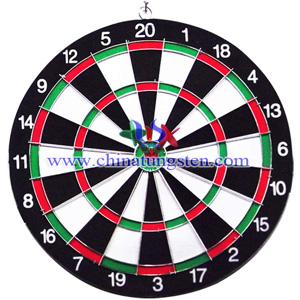The History of Dartboard Numbering Scheme
- Details
- Category: Tungsten Information
- Published on Wednesday, 29 July 2015 17:42
The pseudo-random arrangement of numbers was presumably invented in the 19th century by fairground people along with the very idea of a segmented board. There aren't any pictures of a fairground board prior to 1900 so one can only conjecture but there are two ways to look at the result. It is clear is that some effort has been taken to ensure that consecutive numbers are mostly placed well away from each other and that higher numbers aren't next to each other. Modern players playing in a pub would correctly feel that such a board requires less luck and more skill in order to hit the high numbers. And it would seem likely that a fairground owner would view things similarly - by not grouping the high numbers together it is much harder for a random unskilled punter to hit 3 high numbers in one turn and therefore a fairground stall owner could easily judge the winning threshold to make it tempting while making sure that not many prizes were won!
The oldest known picture of a dartboard is the apparently pre-1900 'Grimsby board' that features 28 semi-randomly situated numbers on a segmented board with doubles. This appears to relate to a game of skill rather than a fairground pastime.
The segmented numbering scheme that features on the London or Standard Board is inherited from the old Yorkshire, Burton, Irish and Lincoln boards which have a similar arrangement. Many people have written in to ask how this came about and, although there is no definite answer, here are some facts concerning 2 competing theories so that you can draw your own conclusions.
The most commonly espoused theory is that it was invented by a Brian Gamlin, a 44 year old carpenter from Bury, Lancashire in 1896. However, there is only one source for this story and Patrick Chaplin, who knows more about tungsten darts than anyone else, has hunted high and low for any evidence that Brian Gamlin ever existed and could find none. Arthur Taylor who knows more about pub games in general than anyone else is similarly cynical. Further, the first record of the numbering sequence anywhere is print is from 1916 and the idea that the board remained a rare thing for 20 years at that time, given that Gamlin apparently died in 1903 lacks credence.
Chaplin favours one Thomas William Buckle from Yorkshire as the most likely contender for the famous numbering scheme. A craftsman and domino maker, in 1913 he supposedly converted a London Fives Board into the first version of the standard Yorkshire board that we know today. His motive for doing this remains unknown but sometimes historians ask too many questions - maybe he was just tinkering around and thought it might make a good tungsten dart game!

Tungsten Dart Manufacturer & Supplier: Chinatungsten Online - http://www.chinadart.com/
Tel.: 86 592 5129696; Fax: 86 592 5129797
Email: sales@chinatungsten.com
Tungsten & Molybdenum Information Bank: http://i.chinatungsten.com
Tungsten News & Tungsten Prices, 3G Version: http://3g.chinatungsten.com
Molybdenum News & Molybdenum Price: http://news.molybdenum.com.cn



 sales@chinatungsten.com
sales@chinatungsten.com